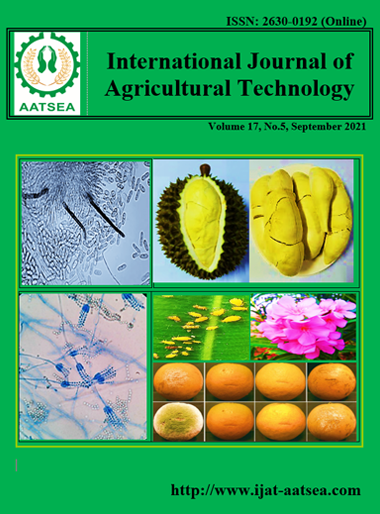Coffee cherry’s pulp variety and pulping delay time leading to cascara tea products
Main Article Content
Abstract
The effect cherry’s pulp variety and pulping delay time after harvest on the physical, chemical, and organoleptic properties of cascara tea products were investigated. The results indicated that all parameters were decreased with the pulpingdelay times, excepts the ash content.The best robusta cascara tea was characterized by 4.90% of yield, 6% of moisture content, the lightest color value 7.5 YR 7/8, 4.01 of pH, 7% of ash content, 241.19 mg/L of polyphenol content, 554.74 mg/ L of tannin content, 32.67 ppm of antioxidant activity and 107.03 mg/L of caffeine content. On the other hand the best arabica cascara tea demonstrated 7.74% of yield, 6.67% of moisture content, the strongest color intensity 5 YR 5/10, 4.33 of pH, 5.33% of ash content, 170.87 mg/L of polyphenol content, 334.91 mg/L of tannin content, 12.80 ppm of antioxidant activity and 56.08 mg/L of caffeine content. The robusta cascara tea excelled in in the moisture content, polyphenol content, and tannin content while the Arabica cascara tea was superior in yield, pH, ash content, antioxidant activity, and caffeine content. In term of organoleptic scores the Arabica cascara tea produced from the fresh pulp was the most preferable for the panelists. All pulps were qualified as raw material for cascara tea production
Article Details

This work is licensed under a Creative Commons Attribution-NonCommercial-NoDerivatives 4.0 International License.
References
Ariva, A. N., Asri, W. AndSarifah, N. (2020). Effect of Drying Temperature on Quality of Cascara Tea from Arabica Coffee Skin (Coffea arabica). Indonesian Journal of Agricultural Technology and Industry, 12:21-28.
Indonesian Standardization Board (ISB). (2006). INS 01-7152-2006 concerning Food Additives - Requirements for Flavors and Uses in Food Products. National Standardization Board. Jakarta.
Indonesian Standardization Board (ISB) (2013).INS 3836:2013 concerning Packaged Dried Tea. Indonesian Standardization Body. Jakarta.
Inti, K. (2008). Herbal Tea Drinks Efficacious Health Restorer. Gramedia, Jakarta p 79.
Barus, W. B. J. (2018). Effect of Fermentation Time and Drying Time on Coffee Powder Quality. Forum for Innovation, 8:111-115.
Chrismirina, S., Afrina and Cut, M. S. (2016). Comparison of Saliva Flow Rate Before and After Consumption of Robusta Coffee (Coffeacannephora). Chakradonya Dent Journal, 8:88-91.
De Bruyn, F., Sophia, J. Z., Vasileios, P., Julio, T., Carles, L., Alice, VM, Michael, C., Wilbert, S., Stefan, W. and Luc, D.V. (2017). Exploring the Impacts of Postharvest Processing on the Microbiota and Metabolite Profiles during Green Coffee Bean Production. Food Microbiology, 83:1-16.
Esquivel, P. and Victor, M. J. (2012). Functional Properties of Coffee and Coffee Products.. Food Research International Journal, 46:488-495.
Galanakis, C. M. (2017). Handbook of Coffee ProcessingBy-Products:Sustainable Application. Academic Press, United Kingdom p 407.
Jakti, R. A. D. R. I. K. and Mita, P. (2011). Theory Reinforcing the Need for Color Naming for Color Books. Humanities, 2:1474-1482.
Molyneux, P. (2014). The Use of the Stable Free Radical Diphenylpicrylhydrazyl (DPPH) for Estimating Antioxidant Activity. Songklanakarin J. Sci. Technology, 26:211-219.
Mubarok, F., Sony, S. andNiken, W. P. (2014). Changes in Caffeine Levels of Arabica Coffee Beans Resulting from Semi Wet Processing with Variations in Treatment Types of Containers and Duration of Fermentation. Agricultural Scientific Periodic, 1:1-7.
Nafisah, D. and Tri, D. W. (2018). A Study of Drying Methods and Brewing Ratios in the Process of Making Cascara Arabica Coffee (Coffea arabica L.). Journal of Food and Agroindustry, 6:37-47.
Nurhayati, Sih, Y. and Aurora, U. (2020). Physicochemical and Sensory Characteristics of Kombucha Cascara (Ranum Coffee Skin). Journal of Food Technology and Industry, 31:38-49.
Pratiwi, A., Elfita and Riris, A. (2012). Effect of Fermentation Time on Physical and Chemical Properties in the Making of Kombucha Drink from Seaweed Sargassum sp. Maspari Journal, 4: 11-136.
Prayitno, S. P., Guntoro and Sri, S. U. (2019).Types of Equipment and Drying Time on Quality in Cascara Coffee Making. National Seminar on the Results of Community Service and Research on Educational Laboratory Institutions. JemberState Polytechnic,pp. 321-324.
Priandana. K., Ahmad, Z. S. andSukarman (2014). Mobile Munsell Soil Color Chart Based on Android Using HVC Image Space Histogram with KNN Classification. Journal of Computer Science Agri Informatics, 3:93-101.
Rasouli, H, Mohammad, H. F. and Reza, K. (2017). Polyphenols and Their Benefits: A Review. International Journal of Food Properties, 20:1700-1741.
Sholichah, E., Rizky A., Dewi D., Mirwan A. K., and Harvelly. (2017). By-products of Arabica and Robusta Coffee Skin as a Source of Polyphenols for Antioxidants and Antibacterials. Center for Plantation Products Industry, Bandung.
Simanihuruk, K. and Sirait, J. (2010). Silage of Coffee Fruit Skin as Basic Feed for Growing Boerka Goats. National Seminar on Animal Husbandry and Veterinary Technology. North Sumatra, pp.557-566.
Siringoringo, F. H. T. (2012). Study of Making Coffee Leaf Tea (Coffea Sp). Essay. Food Science and Technology Study Program, Faculty of Agriculture, University of North Sumatra, Medan.
Suhendra, D. andSiska, E. (2020). Changes in Physical Condition of Coffee Fruit (Coffeasp) after Storage for 1 Month. Journal of Agroplasma, 7:65-71.
Utami, R. R. (2018). Cocoa Bean Antioxidants: Effect of Fermentation and Roasting on Their Changes (Review). Journal of the Plantation Products Industry, 13:75-85.


